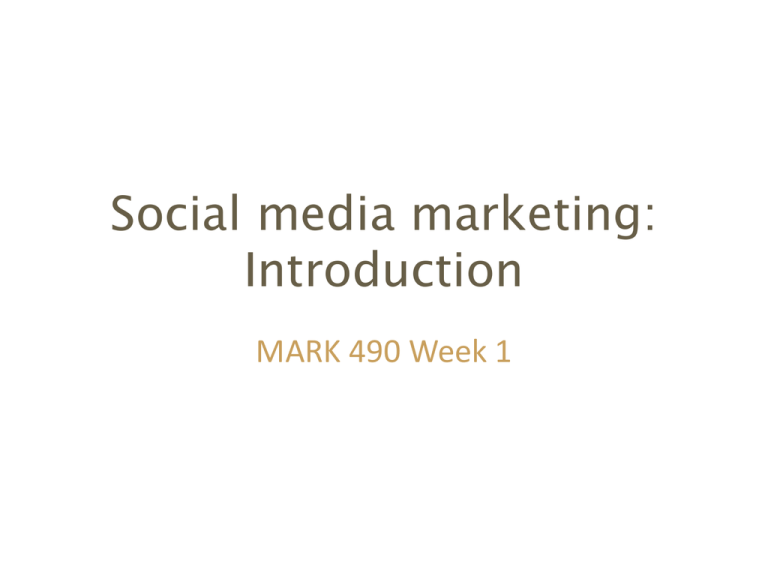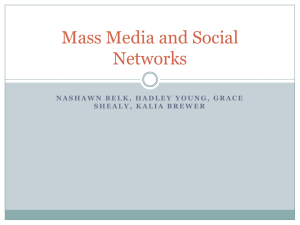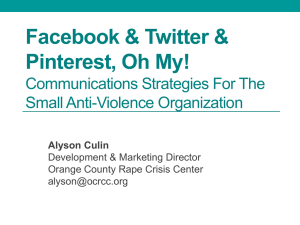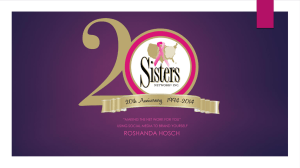Social media marketing: Introduction
advertisement

Social media marketing: Introduction MARK 490 Week 1 Topics for today’s class • Introduction to the course • Definitions of social media and social networks • The history and growth of the “participative internet” • Some key concepts in understanding social networks • Who is doing what online and where and what are they doing? INTRODUCTION TO THE COURSE Where to find course resources • Course philosophy – “Be tools agnostic! Build engagement strategy around function, goals, and purpose - not specific tools.” Baer & Naslund • • • • Course outline Course website Assignment information Consent form SOME KEY DEFINITIONS AND CONCEPTS Terms and Definitions • • • • • Social media Social network Network effect Social Graph Dunbar Number / Attention economy Social media • "a group of Internet-based applications that build on the ideological and technological foundations of Web 2.0, and that allow the creation and exchange of user-generated content.“ Andreas Kaplan and Michael Haenlein • Also sometimes called “consumer-generated media” • So this defines social media as a technical mechanism - but what makes it *social*? Social network (hint, it’s all about people) • A network of social interactions and personal relationships.” Oxford English Dictionary • “Networks are held together based on interpersonal relationships” Daniel Newman • Community? Key concept: the network effect • The network effect – what does it mean? • Related concept: “walled garden” Image Source: Wikipedia 2 approaches to getting a viable network effect – solving the chicken and egg problem Building the Next WhatsApp or Instagram: The Network Effect Playbook 1. the ‘connection first’ strategy: get as many people connect as you can (Facebook, Twitter) 2. The “content-first” strategy: “provide users with tools to create a corpus of content, and then enable conversations around that content” (Pinterest, Instagram) Key concept: The social graph Social graph defined: "the global mapping of everybody and how they're related“ (Brad Fitzpatrick) Think: “six degrees of separation” Using Social Graphs to Understand Your Network Part 1 and Part 2 Data visualizations of your social graph are available from LinkedIn and Facebook But what about Dunbar’s Number? • Is there a biological constraint on social interaction? • Dunbar (1992) measured “correlation between neocortical volume and typical social group size in a wide range of primates and human communities” • Found the maximum number of “stable interpersonal relationships” that can be maintained to be between 100200 • A person's time is finite – this gives rise to the idea that “attention and time are scarce resources”. Hence the concept of “The Attention Economy” • Seth Godin appears to agree in this short video Modeling Users' Activity on Twitter Networks: Validation of Dunbar's Number How a network collapses • The death of Friendster – lessons learned • It takes more than a large number of active users, those users need strong ties or the network will collapse The Friendster Autopsy: How a Social Network Dies (Robert McMillan. Wired. February 2013) Messaging services utilize “close ties” – very rapid growth recently From: Mary Meeker, Internet Trends 2014 (KPCB) Frequency of communication more valuable than # of contacts From: Mary Meeker, Internet Trends 2014 (KPCB) THE HISTORY AND GROWTH OF THE “PARTICIPATIVE INTERNET” Pre-web social media – 70s & 80s online life MUD (Multi User Dungeon) 1978 UseNet / Newsgroups – search here 1978 BBS (Bulletin Board System) 1979 Listserv (automated mailing list) 1985 The Well – the first “virtual community” still going, kind of 1986 1988 IRC (Internet Relay Chat) – still used by many people Then came the web – March, 1989 • The First Generation Web (1989 – 2003-ish) – Publishing medium; predominantly one-way / asymmetrical • The Next Generation: Web 2.0 – What is Web 2.0? (Tim O’Reilly) • Web 2.0 ... The Machine is Us/ing Us - the classic viral video by Mike Wesch from 2007 – The participative web – Publishing tools in the hands of users – communication now 2way – User-generated content – The web is “us” – Focus on the user/participant – Media becomes “social” The first “modern” social media Six Degrees – first social network with user profiles (closed in 2001) 1997 Napster (eventually merged with Rhapsody in 2011) 1999 LiveJournal (still alive and living in Russia) 1999 Epinions (killed off in 2014 by owner eBay) 1999 Blogger (acquired by Google in 2003) 1999 Friendster (died 2009) 2001 Wikipedia 2002 2003 MySpace (sold by NewsCorp in 2011. Relaunched 2013) Institutions versus collaboration • Clay Shirky's forward-looking TED talk from 2005: Institutions vs. Collaboration (20m) WHO IS DOING WHAT ONLINE AND WHERE AND WHAT ARE THEY DOING? Social networking demographics • The following slides contain data from the Pew Research Internet Project (USA data only) • Up to date Canadian statistics more difficult to get – eMarketer: Canada Neck and Neck with US on Social Network, Facebook Penetration (2014) – eMarketer: Social Usage varies between men and women in Canada (2015) – ComScore: 2013 Canada Digital Future in Focus Report – Canadian Digital Media Network Comparison of usage • Pinterest, Instagram, Twitter, and LinkedIn growing, but Facebook has flat growth but remains dominant Pew Research Internet Project. Social Media Update 2014 Frequency of social media site use • Facebook, Instagram, and Twitter have highest engagement levels, with multiple daily usage. Pew Research Internet Project. Social Media Update 2014 Demographics • Facebook popular across a diverse mix of demographic groups – most growth among seniors • Pinterest - women still more likely than men to be Pinterest users (42% of online population versus 13%) • LinkedIn - especially popular among college graduates and higher income households. • Twitter and Instagram - younger adults, urban dwellers, and non-whites. • Substantial overlap between Twitter and Instagram user bases • Demographics of key social networking platforms – useful for the detail Pew Research Internet Project. Social Media Update 2014 Number of social media sites used • 52% of internet users use two or more of the social media sites (Facebook, Twitter, Instagram, Pinterest, and LinkedIn) – multiple site usage being a rising trend Pew Research Internet Project. Social Media Update 2014 Social media matrix • • The proportion of Facebook users who also use another platform increased significantly since August 2013 for each platform. That is, there are more Facebook users this year who also use another service. Significant level of overlap between Instagram and Twitter users – 58% of Twitter users also use Instagram, and 52% of Instagram users also use Twitter. Pew Research Internet Project. Social Media Update 2014 Global Web Index January 2015 To end today’s class • A look at your use of social media • Short anonymous survey on Google Drive • http://web.viu.ca/thomasb/mark_490_survey.html • (link is also on the course website with the materials for today’s class)






